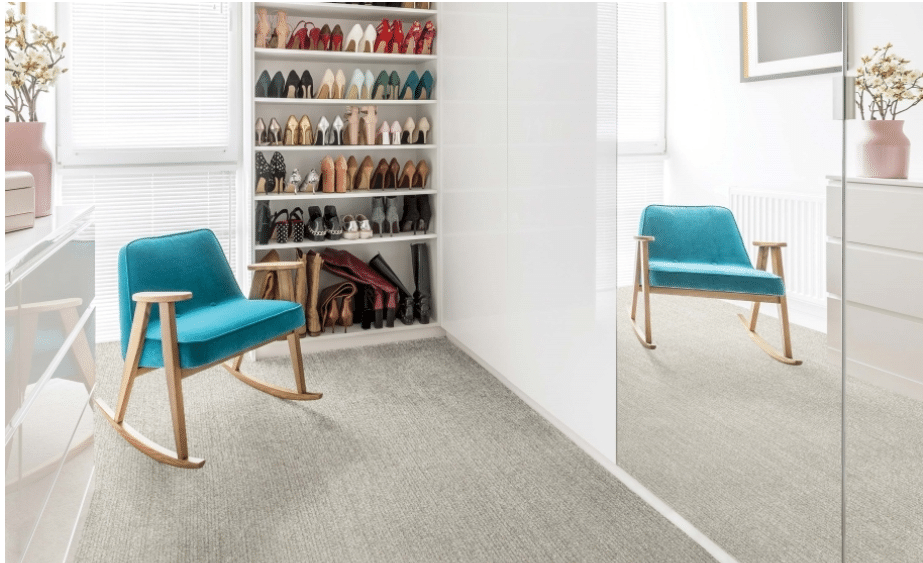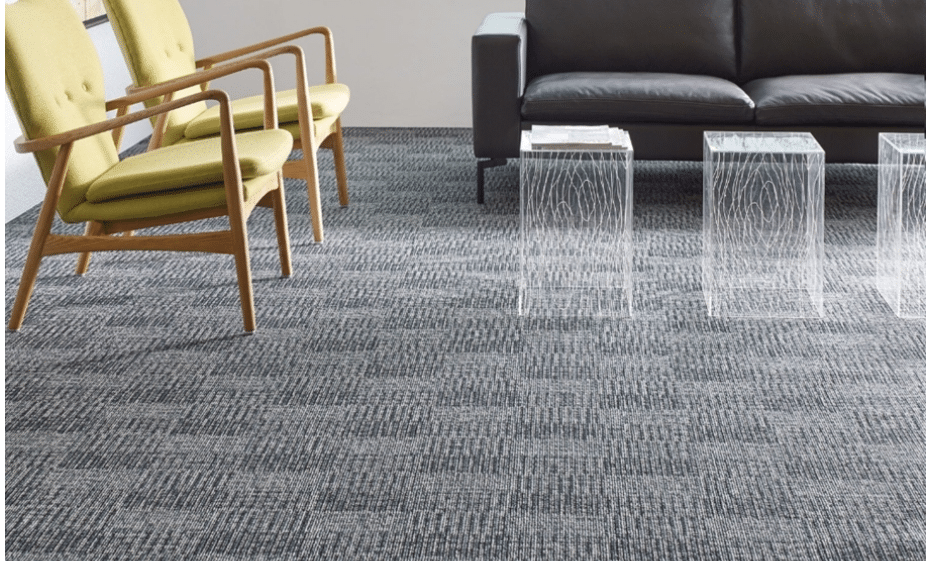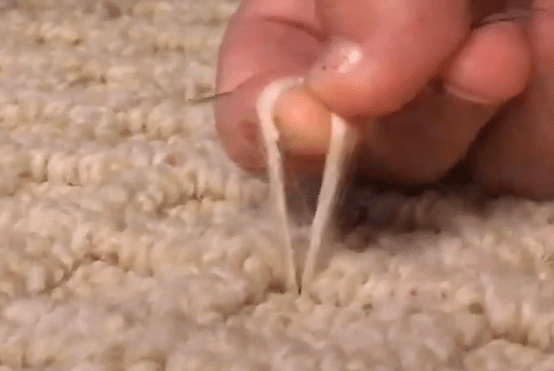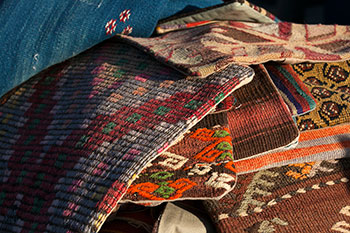Are the ‘90s coming back in style? If you’ve seen a familiar carpet being installed in various businesses and houses around you, it might be time to consider it as an option for your home as well. First, though, you’ll want to know what is Berber carpet, where does it come from, and how can you decide if it’s a good fit for your home.
Our latest guide will reveal the history of this carpet style, its significant advantages, disadvantages, how to properly take care of it, and much more.
If you’re a pet parent, you already know how important it is to choose a suitable flooring style. Will Berber carpeting be a good fit for your furry friends? Start reading to find out.
What is a Berber Loop Carpet?
Berber carpeting is one of the oldest carpet types, and it’s returning to the big stage. If you’re a ‘90s child, you probably remember it because it was everywhere you turned. How did its history begin, and where did it first appear?
Berber is often referred to as loop-style carpeting because of the many loops that the fibers create. The loops are placed right next to each other and form a tight-knit carpet structure.
Although most people remember it from three decades ago, the roots of Berber date back much further than that. This is actually one of the oldest carpet styles, and these Berber carpets were originally made by North African people known as Berbers.
Today, Berber carpeting is a favorite for homeowners, especially for high-frequency areas such as basements. This is one of the most durable carpets, so it’s not strange that you’ll see it in many houses. Another frequent location of Berber is in schools and public places that see a lot of foot traffic.
Styles




Pros of Berber Carpet
Durability
One of the primary reasons people love this carpet style is that it’s surprisingly durable. You can place this carpet in the busiest room in the home, and it will stay looking as good as new.
Why is this carpet more durable than similar alternatives? The looped fibers make it stronger, but they’re also the weakest link. In addition, looped fibers are better than cut fibers, but you have to maintain them properly.
There are many types of Berber carpeting on the market, so when looking at two different carpet types you have to know that more expensive versions will be much more long-lasting than affordable alternatives.
Even if you don’t nail the maintenance this carpet will be there for you for at least two decades, but the better the quality and care, the longer this carpet will last. On average, you can expect it to be in your home for around 15 years.
Easy Maintenance
Did you know that this carpet is one of the easiest to clean? It rarely stains, and even if it does the looped fibers will hide it.
Aside from being priced appropriately, this carpet type tends to keep liquids on the surface when messes happen. The stain won’t get to the deeper parts, and you’ll be able to easily remove the mess. Also, since the stain won’t reach the bottom it will be much easier to clean even if you don’t tackle it right away.
Barber carpeting might be neutral in color, but it usually features tiny flecks of color all over the surface. Another reason why the maintenance is simple is that the flecks hide dirt, dust, and debris. Living with dirty carpets is not a great idea; however, not having to vacuum in a rush when unexpected guests come visiting is definitely a huge pro.
The maintenance process of these carpets is very straightforward. You should vacuum it once or twice a week and clean it with a professional or an excellent home carpet steam vacuum once or twice a year.
Move the furniture around when you vacuum so that you can get to all the parts of the carpet and prevent dirt buildup.
Variety of Materials
As we already explained, these carpets are made of loops that are placed in parallel lines; however, not all loops are the same, and that’s one of the characteristics that will determine the quality of your carpet.
The loops can vary from loose to tight and can also be made of various materials. In general, Berber carpeting contains three types of fibers, all man-made. The word you’ll see everywhere is olefin, which is the most commonly used fiber in producing these carpets.
If you’re looking for a natural alternative, you should find carpets made of wool; unfortunately, they are much rarer and will very likely be quite expensive. Blends of olefin and nylon are another available alternative.
When looking for a new carpet, some of the frequent options you’ll encounter include cut pile, simple loop, cut and loop, patterned loop, multi-color loop, and more.
Stain Resistant
Although we discussed the stain resistance of this material in a previous section, we still wanted to mention it as a separate pro. Having a carpet that doesn’t stain easily is a huge advantage.
When liquids spill on your new carpets, they will stick in the top parts because of the dense looped fibers. Even if you don’t get to the spill right away, you won’t struggle with a massive stain.
Cleaning spills is also very straightforward. All you need is a damp towel.
Affordable
The first thing homeowners notice about these carpets is their affordable price. Since Berber carpeting looks so nice and is simple to care for, the low price comes as a huge plus. This is one of the most affordable carpet alternatives on the market, so we highly recommend it if you’re on a limited budget and need something for high-traffic rooms.
The price range of Berber carpets vary, just like with any other product. You can expect the cost to start at $5 and go up to $8 per square foot, but some alternatives cost between $3 and $4. Wool is the high-quality Berber carpet that generally costs more than $8.
The more affordable alternatives are made of nylon or olefin and come in simpler patterns and colors. Before purchasing a carpet, ensure that you choose based on quality and not only low prices.
Cons of Berber Carpet
Snagging
The first disadvantage we want to mention is that these carpets can occasionally snag. The loops are strong and durable, but a strong or sudden force can pull them out. You have to avoid dragging furniture and other heavy items before repairs are done, because catching on the snagged loop can cause unraveling and permanent damage.

Luckily, individual carpet snags in small areas can be fixed using a blade.
Not as Soft
This will be disappointing to hear, but Berber carpets are not as soft and comfy to the feet as other carpets are. They’re usually made of synthetic fibers that form strong loops, which is why the carpet won’t be as soft as pile carpets.
Hard to Repair
Unfortunately, when a loop isn’t a loop anymore, things get complicated. If you notice that one of the carpet loops is a weaver, there’s no turning back. The row will continue to unravel, and it will be very hard to fix it.
There are various online kits you can purchase to repair the carpet at home, though. They’re generally affordable and suitable for small damages.
Back To TopBerber Rugs and Homes With Pets
Unfortunately, this carpet is not a good alternative for homes with pets. It might be kid-friendly and durable, but cats and dogs can easily damage the loops with their claws and also damage their nails and claws by getting them stuck in the loops. Also, a pet’s claws getting stuck when they run around the room can eventually lead to a serious injury. Since you don’t want either of those things to happen, you should avoid installing Berber carpeting in homes with pets.

Homes with cats are a particularly bad fit for this carpet. Cats are obsessed with this carpet’s texture, so they will constantly be kneading it with their claws. Even if you have several scratching posts around the home, pets will still prefer the carpet and cause damage. When the loops start unlooping, there is no turning back.
Back To TopHow to Maintain Berber Carpet
Regular vacuuming sessions and cleaning the carpets with a commercial vacuum is all you have to do to maintain them.
Although the process isn’t tricky, there is one downside that you should know about. You should stay away from vacuums with a powerhead or a beater bar because the loops can get into the vacuum head, resulting in strand and carpet damage.
Once a strand is loose, not only will you easily be able to see it, but also it can cause further trouble each time you vacuum. The best way to preserve your Berber carpeting is by turning off the powerhead or beater when vacuuming.
Back To TopFAQs
This carpet is recognizable for the neutral color palette that focuses mostly on brown and grey hues with flecks of color throughout the main color scheme. This carpet is also referred to as loop-style because its fibers create loops that are tightly located to another.
Is Berber carpet style better than regular carpet?
Whether you opt for Berber or regular carpet depends on the room, what you expect from the carpet, and your budget.
Berber is excellent for high-frequency areas because of its durability. If you live in a busy home with kids, you will enjoy having this carpet at home. The loops are dense, strong, and can go through a lot without showing signs of wear and tear,
Since most of these carpets are made of olefin or nylon, their fibers are simple to maintain and are relatively resistant to staining. Even if spills happen, the cleaning process will only take minutes because the spill tends to stick in the top parts of the fibers.
The plush carpets you’ve been seeing are beautiful, but they’re so hard to take care of. Unfortunately, they’re not ideal for high traffic homes and are much more suitable for rooms like the bedroom.
If spills happen on plush carpets, you have to act very fast, and you might end up with a huge stain in the middle of the living room. On the other hand, there is no doubt that their appearance is quite alluring. As we mentioned, you should consider the room traffic and how much you’re willing to pay.
Conclusion
You might not have heard of this carpet style, but you’ve definitely seen it many times before. If you’re wondering whether you should opt for Berber or a fluffy carpet, then the guide we provided should be of enormous help.
Some of the most significant advantages of Berber carpeting are its affordable style, durable character, variety of materials, simple maintenance, and stain resistance. Although there are a few drawbacks, such as snagging and a challenging repair process, this carpet style is an excellent option for high-traffic areas.
If you have any comments or first-hand experiences with this carpet style, please post them below or share your pictures via our social media.
Back to Top